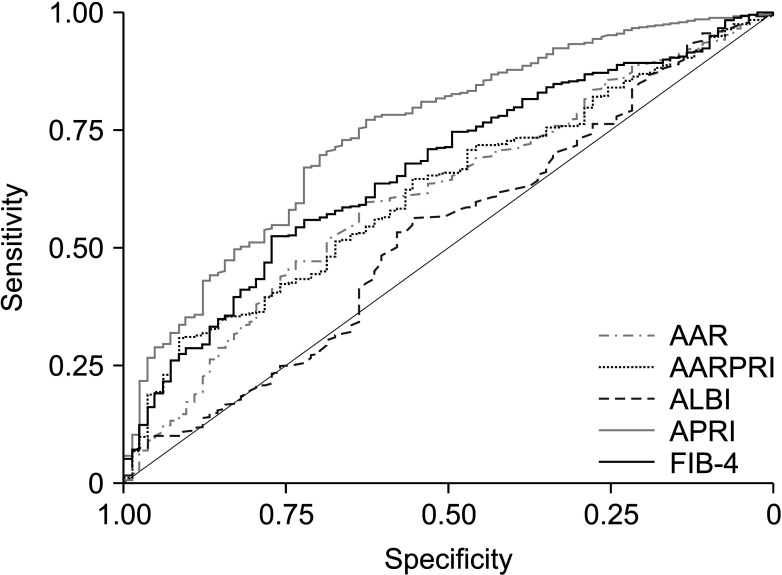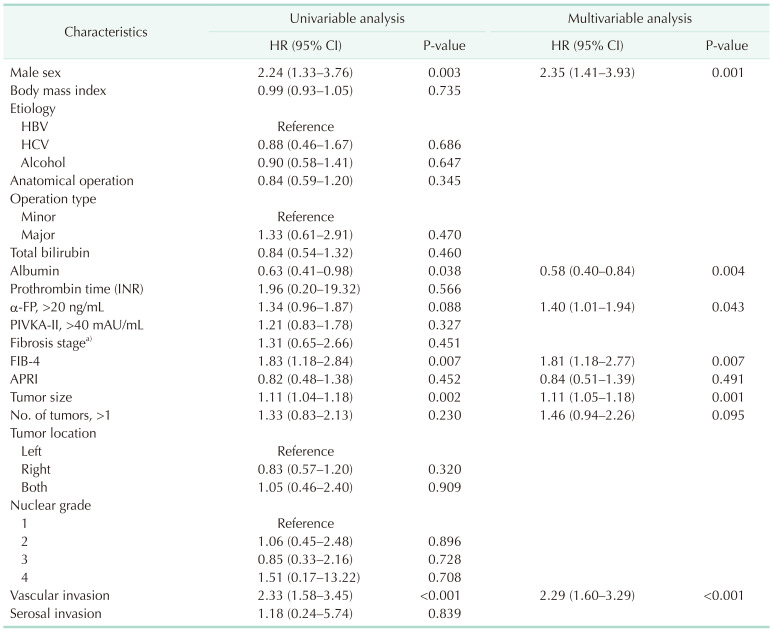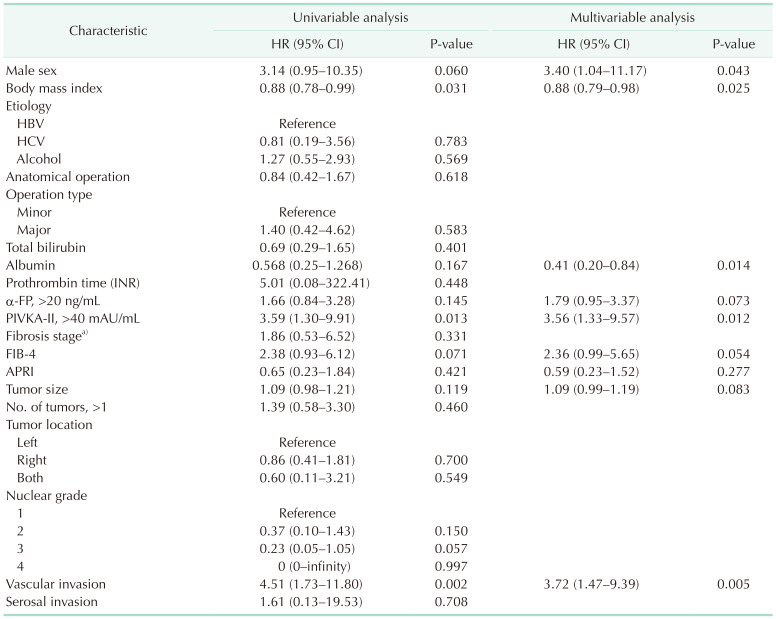1. Heimbach JK, Kulik LM, Finn RS, Sirlin CB, Abecassis MM, Roberts LR, et al. AASLD guidelines for the treatment of hepatocellular carcinoma. Hepatology. 2018; 67:358–380. PMID:
28130846.
2. Torrecilla S, Sia D, Harrington AN, Zhang Z, Cabellos L, Cornella H, et al. Trunk mutational events present minimal intra- and inter-tumoral heterogeneity in hepatocellular carcinoma. J Hepatol. 2017; 67:1222–1231. PMID:
28843658.
3. Jaruvongvanich V, Sempokuya T, Wong L. Is there an optimal staging system or liver reserve model that can predict outcome in hepatocellular carcinoma? J Gastrointest Oncol. 2018; 9:750–761. PMID:
30151272.
4. van Meer S, van Erpecum KJ, Sprengers D, Coenraad MJ, Klümpen HJ, Jansen PL, et al. Hepatocellular carcinoma in cirrhotic versus noncirrhotic livers: results from a large cohort in the Netherlands. Eur J Gastroenterol Hepatol. 2016; 28:352–359. PMID:
26629867.
5. Pandey D, Lee KH, Wai CT, Wagholikar G, Tan KC. Long term outcome and prognostic factors for large hepatocellular carcinoma (10 cm or more) after surgical resection. Ann Surg Oncol. 2007; 14:2817–2823. PMID:
17690940.
6. Rockey DC, Caldwell SH, Goodman ZD, Nelson RC, Smith AD. American Association for the Study of Liver Diseases. Liver biopsy. Hepatology. 2009; 49:1017–1044. PMID:
19243014.
7. Lurie Y, Webb M, Cytter-Kuint R, Shteingart S, Lederkremer GZ. Non-invasive diagnosis of liver fibrosis and cirrhosis. World J Gastroenterol. 2015; 21:11567–11583. PMID:
26556987.
8. Bedossa P, Carrat F. Liver biopsy: the best, not the gold standard. J Hepatol. 2009; 50:1–3. PMID:
19017551.
9. Li X, Xu H, Gao P. Fibrosis index based on 4 factors (FIB-4) predicts liver cirrhosis and hepatocellular carcinoma in chronic hepatitis C virus (HCV) patients. Med Sci Monit. 2019; 25:7243–7250. PMID:
31558693.
10. Marrero JA, Fontana RJ, Barrat A, Askari F, Conjeevaram HS, Su GL, et al. Prognosis of hepatocellular carcinoma: comparison of 7 staging systems in an American cohort. Hepatology. 2005; 41:707–716. PMID:
15795889.
11. Kim WR, Berg T, Asselah T, Flisiak R, Fung S, Gordon SC, et al. Evaluation of APRI and FIB-4 scoring systems for non-invasive assessment of hepatic fibrosis in chronic hepatitis B patients. J Hepatol. 2016; 64:773–780. PMID:
26626497.
12. Imai H, Kamei H, Onishi Y, Ishizu Y, Ishigami M, Goto H, et al. Diagnostic usefulness of APRI and FIB-4 for the prediction of liver fibrosis after liver transplantation in patients infected with hepatitis C virus. Transplant Proc. 2018; 50:1431–1436. PMID:
29705278.
13. Tsoris A, Marlar CA. Use of the Child Pugh score in liver disease. StatPearls [Internet]. StatPearls Publishing;2022. updated 2022 Mar 18. cited 2023 March 18. Available from:
https://www.ncbi.nlm.nih.gov/books/NBK542308/
.
14. Zou H, Yang X, Li QL, Zhou QX, Xiong L, Wen Y. A comparative study of albumin-bilirubin score with child-pugh score, model for end-stage liver disease score and indocyanine green R15 in predicting posthepatectomy liver fai lure for hepatocellular carcinoma patients. Dig Dis. 2018; 36:236–243. PMID:
29495004.
15. Tsilimigras DI, Bagante F, Sahara K, Moris D, Hyer JM, Wu L, et al. Prognosis after resection of Barcelona Clinic Liver Cancer (BCLC) stage 0, A, and B hepatocellular carcinoma: a comprehensive assessment of the current BCLC classification. Ann Surg Oncol. 2019; 26:3693–3700. PMID:
31267302.
16. Kim JM, Kwon CH, Joh JW, Yoo H, Kim K, Sinn DH, et al. Nomograms in hepatectomy patients with hepatitis B virus-related hepatocellular carcinoma. J Gastrointest Surg. 2019; 23:1559–1567. PMID:
30671793.
17. Korean Liver Cancer Study Group (KLCSG). National Cancer Center, Korea (NCC). 2014 Korean Liver Cancer Study Group-National Cancer Center Korea practice guideline for the management of hepatocellular carcinoma. Korean J Radiol. 2015; 16:465–522. PMID:
25995680.
18. Tan CH, Low SC, Thng CH. APASL and AASLD consensus guidelines on imaging diagnosis of hepatocellular carcinoma: a review. Int J Hepatol. 2011; 2011:519783. PMID:
22007313.
19. Kim JM, Kwon CH, Joh JW, Park JB, Lee JH, Kim SJ, et al. Differences between hepatocellular carcinoma and hepatitis B virus infection in patients with and without cirrhosis. Ann Surg Oncol. 2014; 21:458–465. PMID:
24132624.
20. Li J, Mao RC, Li XL, Zheng JW, Qi X, Yuan Q, et al. A novel noninvasive index for the prediction of moderate to severe fibrosis in chronic hepatitis B patients. Dig Liver Dis. 2018; 50:482–489. PMID:
29396134.
21. Wu D, Rao Q, Chen W, Ji F, Xie Z, Huang K, et al. Development and validation of a novel score for fibrosis staging in patients with chronic hepatitis B. Liver Int. 2018; 38:1930–1939. PMID:
29654711.
22. Kayadibi H, Yilmaz B, Ozgur Yeniova A, Koseoglu H, Simsek Z. Development and evaluation of a novel noninvasive index for predicting significant fibrosis, advanced fibrosis, and cirrhosis in patients with chronic hepatitis B infection. Eur J Gastroenterol Hepatol. 2021; 33(Suppl 1):e121–e130. PMID:
33177385.
23. Kim JM, Rhu J, Ha SY, Choi GS, Kwon CH, Joh JW. Hepatectomy outcomes in patients with hepatitis C virus-related hepatocellular carcinoma with or without cirrhosis. Ann Surg Treat Res. 2022; 102:1–9. PMID:
35071114.
24. Ahn KS, Kang KJ. Appropriate treatment modality for solitary small hepatocellular carcinoma: radiofrequency ablation vs. resection vs. transplantation? Clin Mol Hepatol. 2019; 25:354–359. PMID:
31006225.
25. Kim JM, Kwon CH, Joh JW, Park JB, Lee JH, Kim SJ, et al. Outcomes after curative hepatectomy in patients with non-B non-C hepatocellular carcinoma and hepatitis B virus hepatocellular carcinoma from non-cirrhotic liver. J Surg Oncol. 2014; 110:976–981. PMID:
25171344.
26. Okajima C, Arii S, Tanaka S, Matsumura S, Ban D, Ochiai T, et al. Prognostic role of Child-Pugh score 5 and 6 in hepatocellular carcinoma patients who underwent curative hepatic resection. Am J Surg. 2015; 209:199–205. PMID:
25312843.
27. Wang YY, Zhong JH, Su ZY, Huang JF, Lu SD, Xiang BD, et al. Albumin-bilirubin versus Child-Pugh score as a predictor of outcome after liver resection for hepatocellular carcinoma. Br J Surg. 2016; 103:725–734. PMID:
27005482.
28. Wai CT, Greenson JK, Fontana RJ, Kalbfleisch JD, Marrero JA, Conjeevaram HS, et al. A simple noninvasive index can predict both significant fibrosis and cirrhosis in patients with chronic hepatitis C. Hepatology. 2003; 38:518–526. PMID:
12883497.
29. Kim HS, Kim BK, Kim SU, Park JY, Kim DY, Song KJ, et al. Association between level of fibrosis, rather than antiviral regimen, and outcomes of patients with chronic hepatitis B. Clin Gastroenterol Hepatol. 2016; 14:1647–1656.e6. PMID:
27305847.
30. Tabrizian P, Jibara G, Shrager B, Schwartz M, Roayaie S. Recurrence of hepatocellular cancer after resection: patterns, treatments, and prognosis. Ann Surg. 2015; 261:947–955. PMID:
25010665.
31. Ahmad W, Ijaz B, Javed FT, Gull S, Kausar H, Sarwar MT, et al. A comparison of four fibrosis indexes in chronic HCV: development of new fibrosis-cirrhosis index (FCI). BMC Gastroenterol. 2011; 11:44. PMID:
21507271.
32. Shiha G, Seif S, Eldesoky A, Elbasiony M, Soliman R, Metwally A, et al. A simple bedside blood test (Fibrofast; FIB-5) is superior to FIB-4 index for the differentiation between non-significant and significant fibrosis in patients with chronic hepatitis C. Hepatol Int. 2017; 11:286–291. PMID:
28425016.
33. Cross TJ, Rizzi P, Berry PA, Bruce M, Portmann B, Harrison PM. King's score: an accurate marker of cirrhosis in chronic hepatitis C. Eur J Gastroenterol Hepatol. 2009; 21:730–738. PMID:
19430302.
34. Enomoto H, Bando Y, Nakamura H, Nishiguchi S, Koga M. Liver fibrosis markers of nonalcoholic steatohepatitis. World J Gastroenterol. 2015; 21:7427–7435. PMID:
26139988.









 PDF
PDF Citation
Citation Print
Print










 XML Download
XML Download